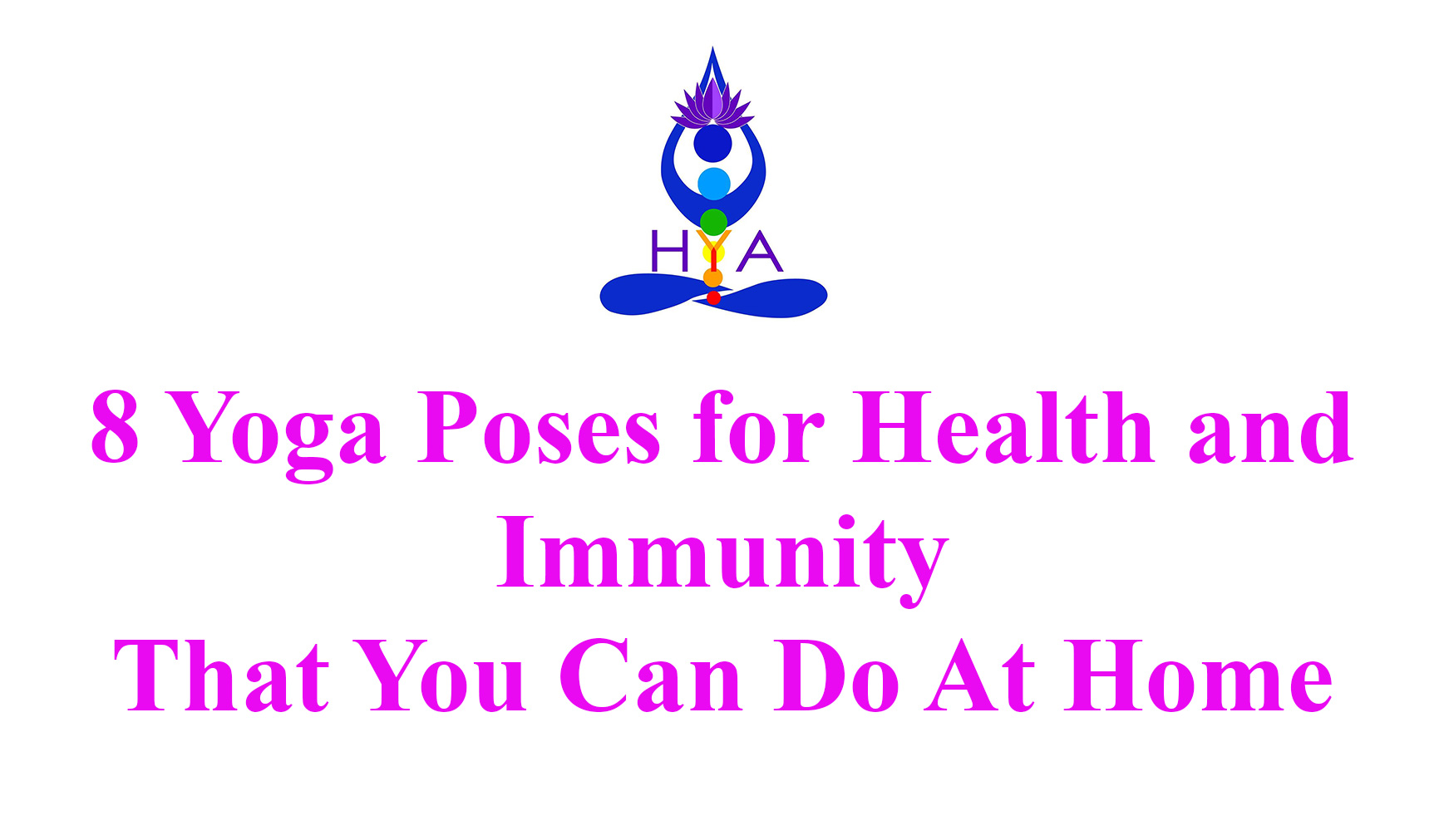
14 May 2022 HYN Himalayan Yoga Academy
How does the immune system work?
The immune system is defined as the combination of systems, glands, organs, and corridors that guard you from germs, bacteria, and other dangerous substances that can make you sick. It’s an essential part of our health and well- and it’s working around the timepiece to defend your body. When the system comes in contact with germs and substances that the body does not feel as its own, the immune system response is actuated. That means, your body begins to fight against the origins, bacteria, and so on to keep you healthy. Still, run-down or stops working duly, it’s unfit to do its job to cover you as it should if your immune system is weak. Hence why it’s so important to nourish our bodies so that we can have a strong, happy immune system.
What are the signs of a weak immune system?
Basically, if you have the following symptoms, you have a weak immune system :
- Your Stress Level is Sky-High
- You Always Have a Cold
- You Have Lots of Tummy Troubles
- Your Wounds Heal Slow
- You Have Frequent Infections
- You Feel Tired All the Time
How can I boost my immune system fast?
There are many ways you can boost your immune system naturally and healthily.
- Always Get a good night’s sleep
- Eat a vegan diet
- Drink a lot of water timely.
- Exercise regularly
- Reduce sugar and alcohol
- Minimize stress
- Practice Yoga!
10 Yoga Poses for Boosting Immunity and Relieving Stress
1. Bhujangasana ( Cobra Pose )
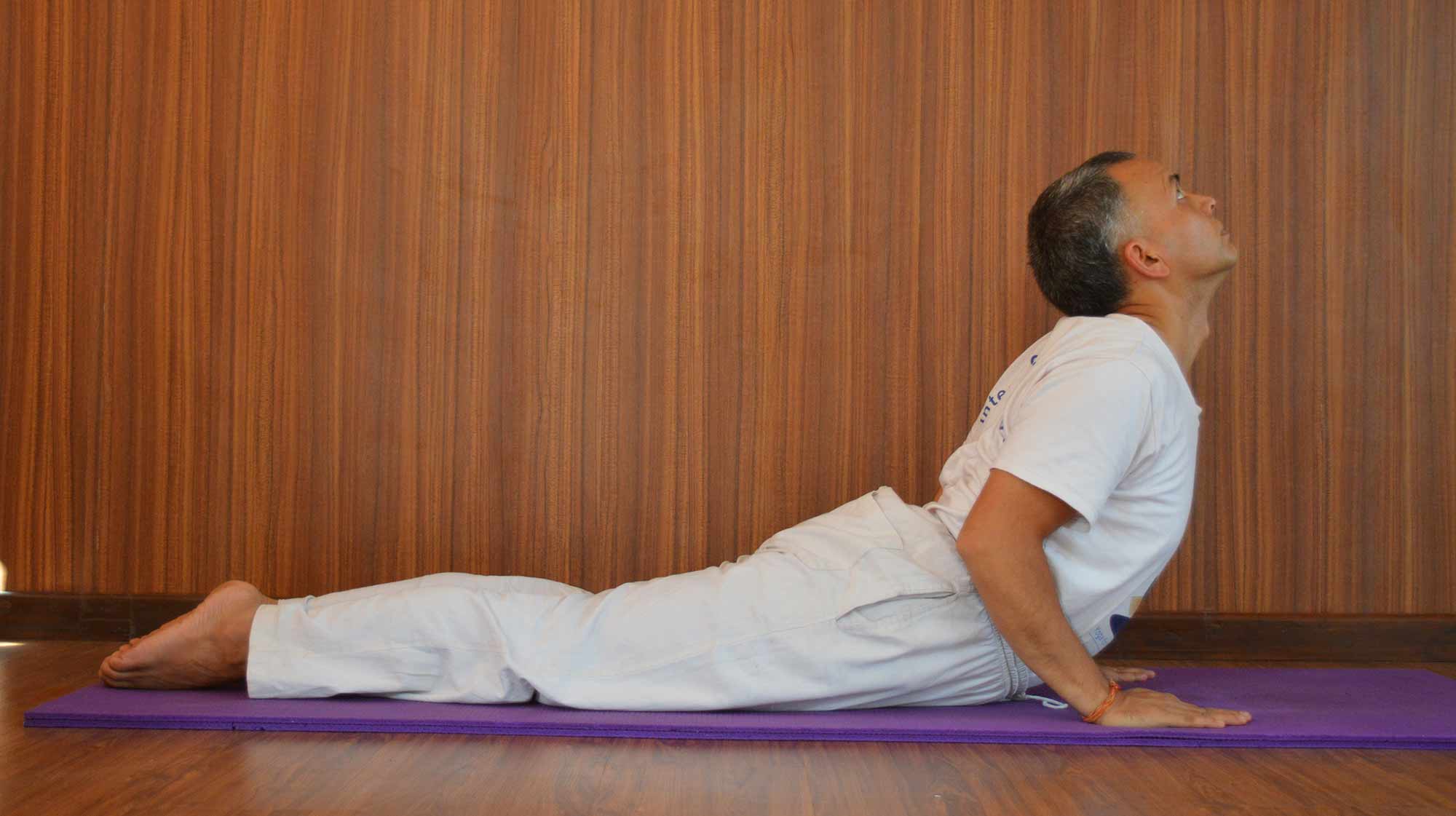
Bhujangasana (भुजंगासना) or the Cobra pose is one of the gentle backbends that helps relieve. Backache, it also helps in improving digestion and overall health of the spine. The cobra pose is often used within a sun salutation or vinyasa as a transitional pose in a collection of asanas.
Steps of doing cobra pose :
The procedure to do Bhujanagasana is very easy. Follow The given steps below without any jerks and stretch as much as you can in the Bhuajangsana yoga. Let us check the steps.
- Lie down flat on your stomach with your head on the floor, legs straight, and feet together.
- Try to raise your head and body up to navel with slow inhalation. You have to set both hands on the ground.
- Now, slowly stretch your whole body.
- Stay in this pose for at least 15 seconds and come back to the ground by a slow exhalation.
2. Uttanasana – Forward Fold
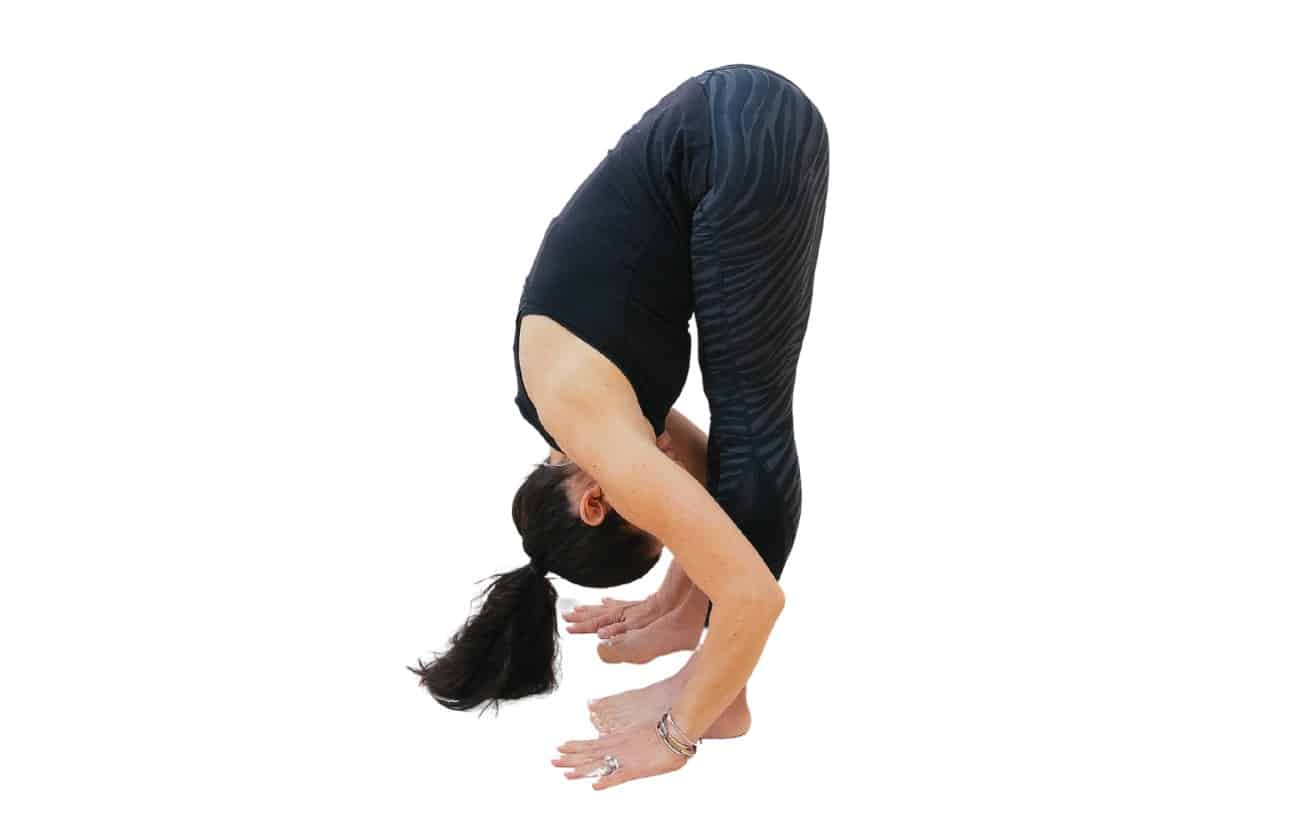
Uttanasana, also known as standing forward fold, is a full-body stretch commonly practiced as a transitional yoga pose in Vinyasa yoga classes. Yogis can also practice holding the posture for an extended period during their practice to reap the benefits of its deep stretches. This standing forward fold is a great pose for counteracting backbends. When practiced correctly under the guidance of a certified yoga teacher, the posture can help relieve back stiffness.
3. Matsyasana – Supported Fish Pose

The Sanskrit word ‘Matsya’ means ‘fish’. It is thus nicknamed ‘The Fish Pose’. Matsyasana is a reclining back-bending asana. The name is derived from the Sanskrit Matsya, meaning “fish,” and asana, meaning “pose.” Matsya is also the name of an incarnation of the god, Vishnu, who manifested himself as a large fish in order to save the earth from a flood.
Steps to perform Matsyasana:
To enter the pose, the practitioner lies flat on the back and then lifts the pelvis so the hands can slide under the buttocks. The back arches and the chest lifts until the crown of the head (or the back of the head for beginners) rests on the floor.
- Begin with the Shavasana (Corpse Pose).
- Maintain a flat back. Make sure your arms are straight, with palms laid out on the mat.
- Gently, bring your palms in under your buttocks.
- Tip your head backward slightly with your torso resting on the floor. Hold for a minimum of 30 seconds.
- Inhale and use your forearms to lift your chest, shoulders, upper back, and head off the mat.
- Bring the top of your head to rest on the mat and hold this position for a minimum of 30 seconds.
- Return to the initial position.
- Relax and inhale.
4. Supta Matsyendrasana – Reclined Spinal Twist
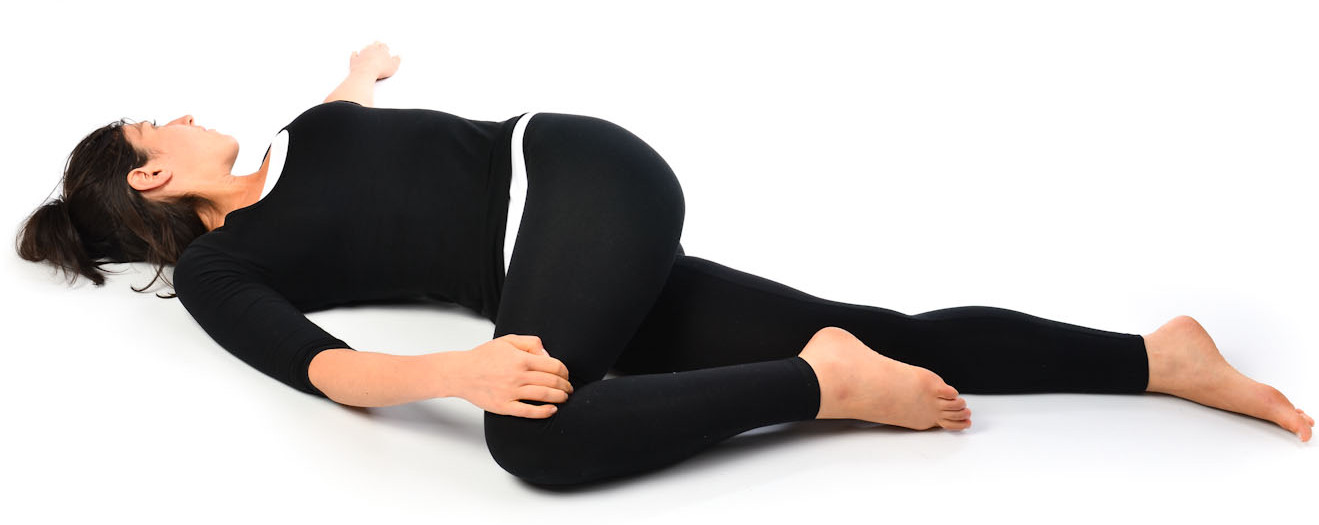
Supine Spinal Twist — Supta Matsyendrasana (Soop-tah-MOTS-yen-drAA-SUN-aa) — is a restorative spinal twist, that lengthens and strengthens the spine while detoxifying the internal organs. Supta Matsyendrasana is a gentle posture that stretches the spine, shoulder, back, thighs, and neck and stimulates internal detoxifying processes, all while the body rests. Regular practice of Supta Natarajasana can relieve lower back pain and tight shoulders. The pose gets its name from the Sanskrit words, Supta, meaning supine or reclined, Matsya, meaning fish, indra, meaning ruler, and Asana, meaning pose.
Step-by-Step Instructions
- Lie on your back with your arms stretched horizontally out to the sides in line with the shoulders.
- Extend your left leg out in front of you and bend your right knee, hugging it into your chest.
- Inhale, and on an exhale slowly cross your right knee over your midline and onto the floor on the left side of your body. Turn your head to the right and look at your right palm.
- Make sure that both of your shoulder blades are touching the ground, even if that means your knee does not fully touch the floor. While twisting, there is a tendency for one shoulder blade to lift off of the ground.
- Feel the stretch in your thighs, groin, arms, neck, stomach, and back as you hold the pose. With each exhalation, relax deeper into the pose.
- Hold for several minutes.
- Slowly turn your head back to the center and straighten your torso and legs.
- Repeat the pose on your left side.
5. Viparita Karani – Legs Up The Wall
Legs Up the Wall is a rejuvenating inverted pose that brings relief to the legs, feet, spine, and nervous system. It is a gentle way to bring the body into a state of deep relaxation and renewal. This pose is recommended for all yoga students, no matter their level of experience.
Its Sanskrit name, “Viparita Karani” (VIP-uh-REE-tuh kah-RAH-nee), literally translates to “inverted action.” When you take time out of your day to reverse the forward motions of doing, acting, and accomplishing, you allow your brain and body to settle into a state of pure being. Settling into this state, then, conditions the mind for deeper meditation, serenity, and self-awareness.
Because of its calming benefits, Viparita Karani is often done at the end of a yoga practice, before the final relaxation pose (Savasana) or meditation. However, it can also be practiced on its own, as an everyday restorative pose.
6. Savasana – Corpse Pose
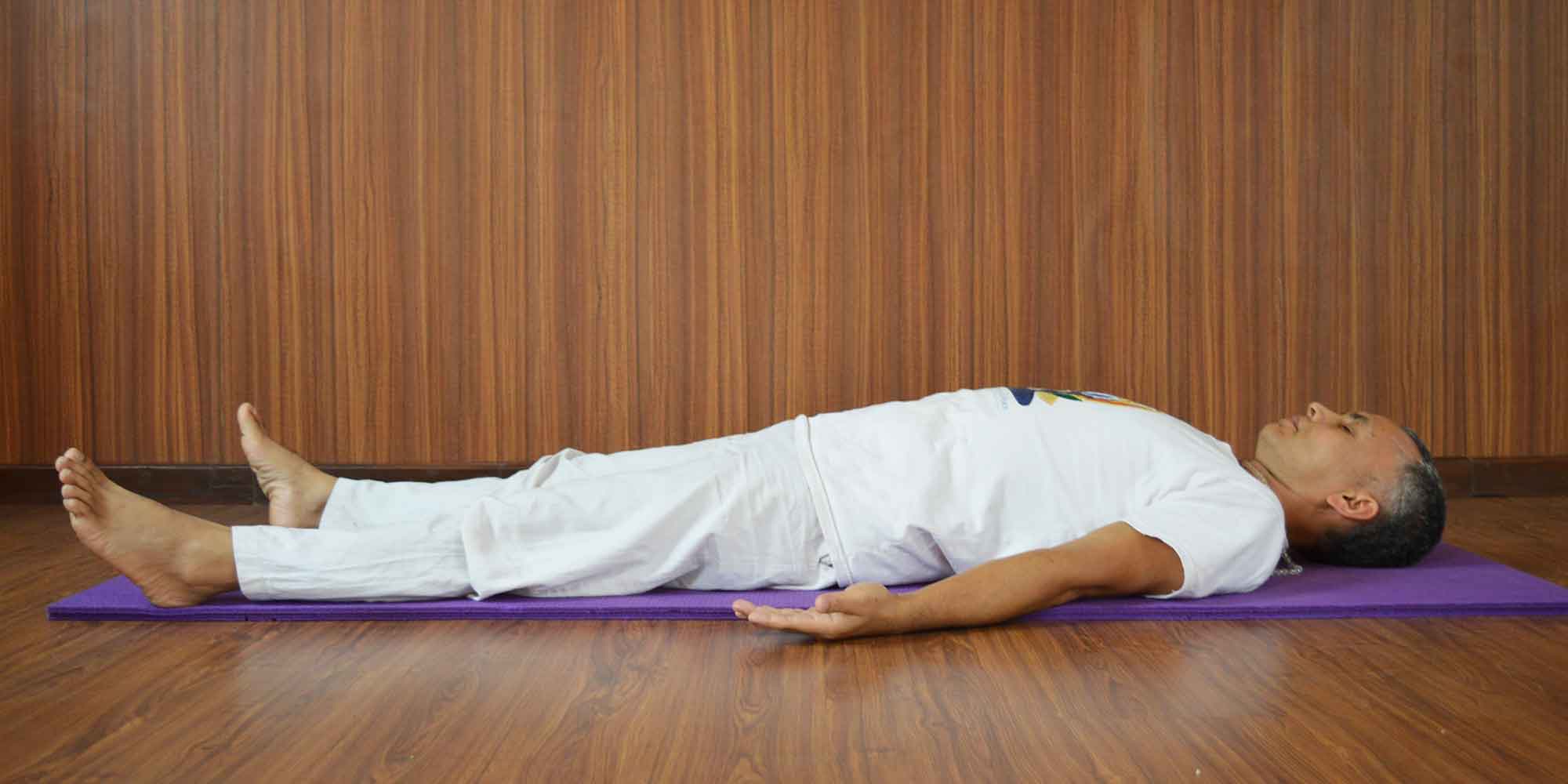
Mritasana, ‘Mrit’ – Corpse/dead body; Asana – Pose; Corpse Pose, or is an asana in hatha yoga and modern yoga as exercise, often used for relaxation at the end of a session. It is the usual pose for the practice of yoga Nidra meditation as well.
Mritasana or Shavasana is the Sanskrit name for an important restorative asana. It is a key component of asana practice in almost every yoga tradition and is most commonly used at the end of a sequence as a means of relaxation and integration.
This pose gets its name from the recumbent posture of a dead body. It is a position of rest, and is usually practiced towards the end of a yoga session – a session that typically begins with activity and ends in rest; a space or pause when deep healing can take place.
7. Setu Bandhasana – Supported Bridge Pose

The Setu Bandha Sarvangasana massages the spine and stretches the chest, neck & hips. It also calms the brain, helps to open the sinuses, reduces headaches, and opens up your shoulders. This is a great pose for women who experience menopausal symptoms.
Steps for Setu Bandhasana Sarvangasana ( Bridge Pose ):
- First of All, Lie down on your back with your arms next to your body, palms facing down. Bend your knees and place your feet near your sitting bones, hip-distance wide.
- Then slowly inhale and lift your hips high. Check if your knees are aligned over your ankles.
- Interlace your fingers on the floor and tuck your shoulders underneath you. Draw your hands toward your feet.
- Stay in the pose for a few minutes with breathing, then release your hands, and exhale to lower.
8. Parivrtta Janu Sirsasana – Revolved Head-to-Knee Pose
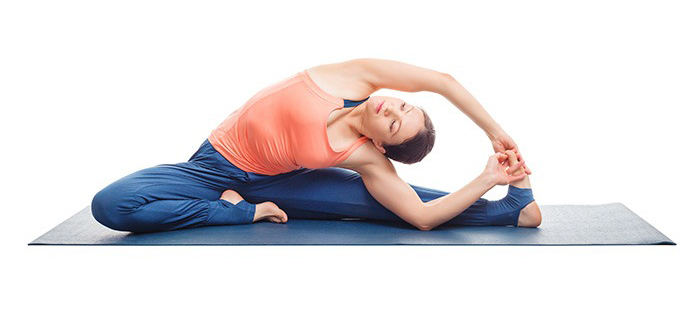
Revolved Head-to-Knee Pose, or parivrtta janu sirsasana in Sanskrit, is a seated twist. From the head-to-knee pose, the practitioner reaches their bottom arm alongside the extended leg and reaches the top arm overhead, grabbing hold of the foot and twisting the torso toward the sky. It gives similar benefits to the head-to-knee pose but further improves circulation to the spine. It also invigorates digestion.
Instructions
- Sit with the legs outstretched.
- Bend the left leg and place the foot near the groin.
- Extend the right arm forward and twist it toward the leg. Grab hold of the inside of the right foot.
- Inhale and reach the left arm up and over. Grab hold of the foot.
- Bend the elbows and twist deeper, turning the torso toward the sky.
- Breathe while holding the pose.
- Exhale and release. Untwist and change sides.
